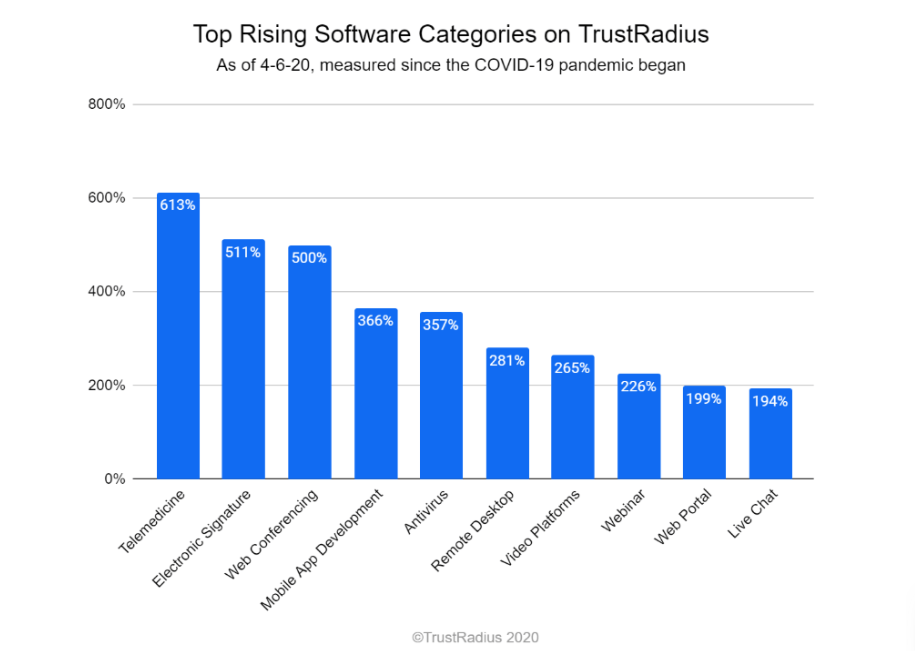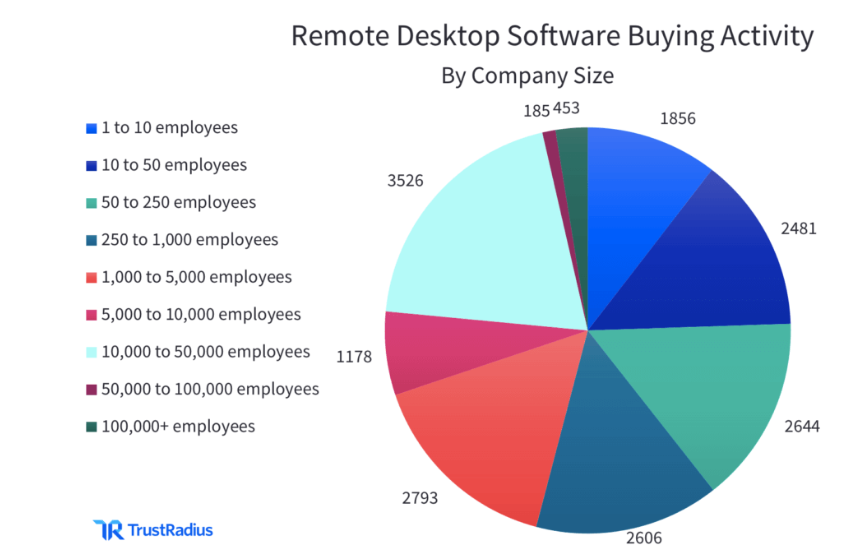Even at the beginning of the COVID-19 pandemic, questions were raised about how to cope with the effect of chaos and uncertainty when it comes to the transition of work to a remote format. According to statistics from Gallup, in the first half of April 2020, the number of such employees increased to 62%. If we compare these figures with 2012, then only 39% of employees worked remotely. Relevant technological solutions are changing, which contributes to increased working capacity and more orderly work. For example, in this context, you can mention the remote desktop, which will be discussed later.
Why is this technology in demand?
The software you need to support remote desktops allows you to stay connected while working productively remotely. If you look at the data published by the TrustRadius resource, then from the beginning of the pandemic until the beginning of April, there was an increase in traffic for remote desktop software by 281%. This indicator is eloquent enough to show some trends.

Demand has also grown for software that is responsible for areas such as learning management or LMS and programs needed for web conferencing. Although in this case, we are talking about some evidence, seeing them at the level of trends, graphs, and percentages is informative. This makes it possible to understand the dynamics of the popularization of certain phenomena.
Is it true that it all started with a pandemic?
When we say the phrase “remote work”, then, first of all, its actualization is associated with the COVID-19 pandemic. However, this form of employment was widespread long before the coronavirus. Accordingly, there was also interest in tools to support remote desktops. It’s just that with the onset of the pandemic, already-known IT or AI tools that were previously considered as an alternative became a necessity.
According to the already cited TrustRadius, after the start of the mentioned events, the biggest surge in the active use of remote desktop software was on March 17th. Throughout March and April 2020, average traffic for this category increased by 1578 percent. Impressive, isn't it? If before that it was 2749 views, now it has become 46363. Below you can find a graph that demonstrates this trend.

This graph shows that the indicator has been overcome, which can be called the peak point of interest in IT products for remote desktop support.
TOP 3 factors that increased the popularity of such software
The demand for this software has grown due to the following reasons:
- Companies that previously worked in the office needed to perform their work tasks remotely.
- It was necessary that communication between employees within the team, as well as between employees and customers, remained uninterrupted.
- There was a need for IT specialists to be able to diagnose and fix user technical problems without leaving their own homes.
Perhaps someone has a question about why March is positioned as the peak month in terms of interest in remote desktop software. There is nothing strange in this. Companies hurried to acquire, as well as to implement these programs as quickly as possible. After these tools began to support their users, the demand for them stabilized. By the way, the trend has embraced both large and small enterprises.
What was the interest in this software in different states?
When we talk about USA RDP, let's go back to the numbers from the already mentioned TrustRadius resource. Next, let's talk about the geography of using various remote desktop tools. This is interesting to consider when compared with the data for the states that were most affected by the pandemic. So, New York was one of the biggest epicenters of the virus. This was massively reflected in the work of enterprises and entire areas. Work processes required restructuring. Companies have switched to a remote work format en masse. However, this did not make New York the top state for remote desktop software usage.
Most often, buyers of IT products from California were looking for various options for this type of software. This trend can be explained from the standpoint of two facts at once:
- The population of California is larger than the population of New York (39.5 million versus 19.5 million).
- It is California which is known as one of the largest technology centers in the state. The very fact that Silicon Valley is here speaks volumes.
Let's turn to one more indicator from the previously mentioned resource. It is worth considering in more detail the scale of organizations for which remote desktop technology is suitable. 46% of traffic belongs to enterprises with more than 1000 employees. This shows that the larger the company, the more it needs to optimize performance.

Why do companies choose this technology?
When employees work from different locations, the IT administrator of the company may have some problems coordinating their activities. Different types of software, manufacturers, and operating systems become an obstacle to well-coordinated work. However, Remote Desktop Connection gives an administrator the ability to control devices over a network connection.
Perhaps for those who do not yet have experience using this tool, it is worth explaining its features in simpler words. A key benefit of using remote desktop software is that you don't have to be physically present at a specific location to log in. Among the aspects that IT administrators consider pluses are:
- Easy access to those devices that are in hard-to-reach places. For example, this can be useful for the work of employees who are often on the road.
- Facilitate the ability to manage the device for the administrator. This employee gets a tool that allows them to change settings, edit permissions, and do many other important work tasks without physical access.
- Ability to save money. This advantage should be considered in more detail. If the troubleshooting technicians can do it remotely, their job is simplified. No need to travel, spend extra time on it. The productivity of specialists increases. The company, by paying their working hours, gets more useful work.
- Connection security. The vast majority of remote desktop software has advanced security options. They are aimed at ensuring that business data is under complete and reliable protection. This is achieved by encrypting the data that is being transmitted.
In addition to all of the above, it is important to note that the teams of such software vendors always have experienced professionals working with servers. Accordingly, this allows the use of modern methods of information protection, which is very important in order to avoid its leakage.
Conclusion
Summing up, it is worth noting:
- Interest in remote desktop software has been around for a long time, but it peaked during the pandemic. Then a record number of users decided to buy RDP VPS.
- The use of such tools has greatly facilitated the work of IT administrators.
- The connection of such software is secure. In this regard, companies do not need to worry about data loss.
Thus, remote desktop software solves many problems when working in a remote format.


 Table of Content
Table of Content










